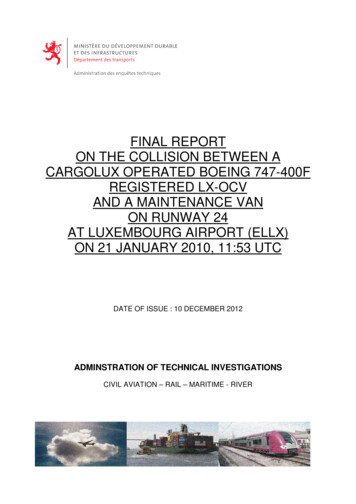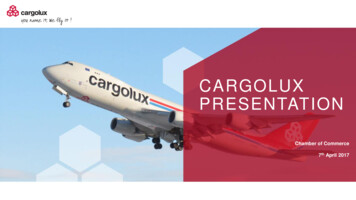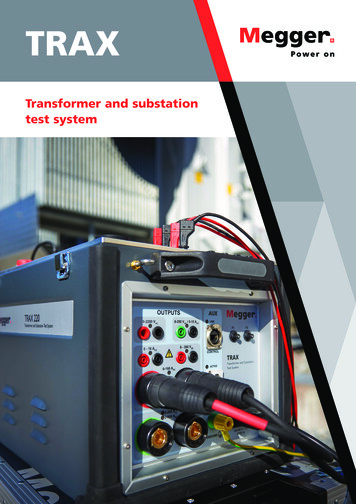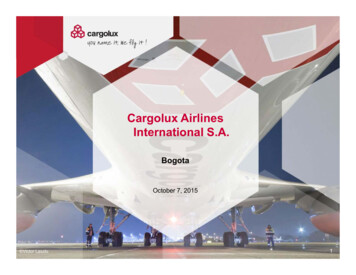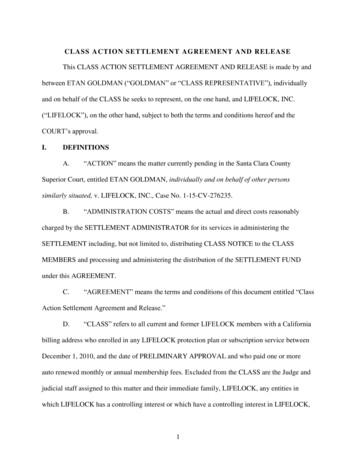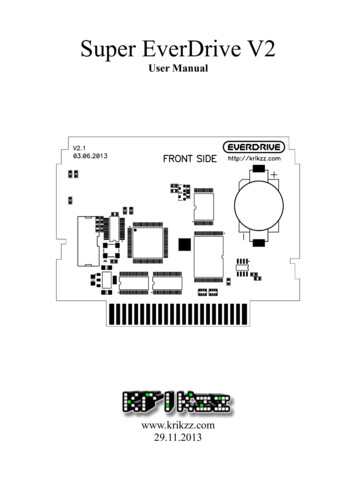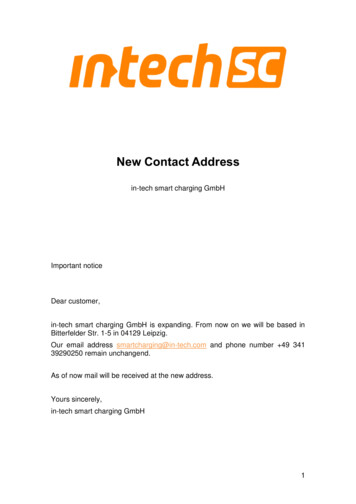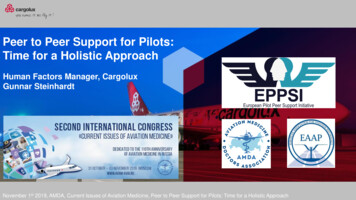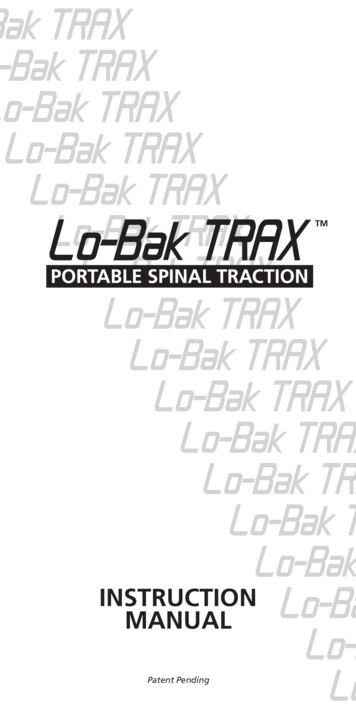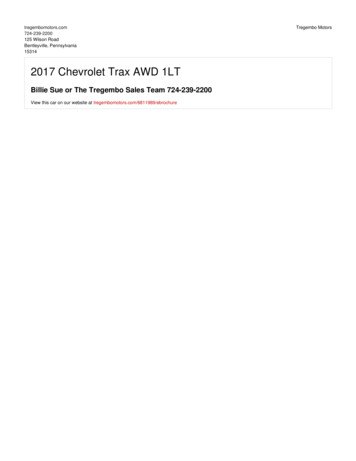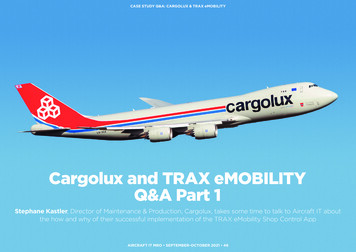
Transcription
CASE STUDY Q&A: CARGOLUX & TRAX eMOBILITYCargolux and TRAX eMOBILITYQ&A Part 1Stephane Kastler, Director of Maintenance & Production, Cargolux, takes some time to talk to Aircraft IT aboutthe how and why of their successful implementation of the TRAX eMobility Shop Control AppAIRCRAFT IT MRO SEPTEMBER-OCTOBER 2021 46
CASE STUDY Q&A: CARGOLUX & TRAX eMOBILITYAircraft IT: Thanks for joining us, Stephane and for sharing with us howCargolux has implemented the TRAX eMobility Shop Control application. Wehave a few questions that we’d like to go through, so, to set the ball rolling,let’s get straight to the first one of those. Can you start by telling us a little bitabout your business case for implementing the app and how you’ve seen itmaximizing your operation?Stephane Kastler: Thanks for the opportunity to share our experience. The shopcontrol app is used in our shop environment. In Cargolux we have ten backshops which support the airline and the maintenance organization, and theirmission is to repair many 747 components for the fleet. At the same time, theyalso support the hangar and the line operation directly. So that’s the positionwe have grown to in the last few years. We repair about 10,000 componentsevery year. That’s a lot of components, many of which are needed urgently orare required on an AOG basis. However, with so many components travelingthrough the different shops, we need to be able to track them and theirprogress.With the increase of our fleet and the rise in the numbers of components thatwe are repairing, it has become very clear that we need to have a system whichshows us an overall priority and progress tracking status on the parts that we arerepairing. That is what the Shop Control app does for us. We are coming from asituation where components were coming off wing in need of repair, and we wouldjust send them to the shop. The shops receive a lot of components and they haveto figure out the priorities as well as figure out what needs to be done on thosecomponents. This creates a large backlog of parts for them, and with a largebacklog comes issues of space, of priorities with other elements of theorganization, etc. That had become a major problem for us.At the same time when you have these ten thousand components which eachsometimes requires a very small action in each of several different shops, it starts tobe very difficult to know where you stand with all these components. So, sometime ago we decided that we need to create a system – a process let’s say – whichcould control the inductions of our parts into the shops system. We also need tocontrol the induction of parts into our ten shops, and once the part is inducted intothe system, we have to make sure that it has the right priority and that we can trackit in real time. That’s basically what the Shop Control project was for.The Shop Control app gives us a way to decide when the part needs to be sentto the shop for repair, when is it needed, and when it has been released. We cantrack in real time what is happening to that part and that’s extremely critical. Bydoing this we manage the parts, manage the parts ‘in process’, reduce turnaroundtime, and we are able to take the right decisions and to repair the right part at theright time. That is where the added value is, of course. The turnaround time isimmediately linked to the number of parts that need to be held in stock. So, thebetter we are in turnaround time the better we are supporting the airline.Aircraft IT: That was very clear, thank you. How, then, do you think that themaintenance digitization has impacted your profitability?SK: What we are looking at in Cargolux is to have the best way possible formechanics to focus on their core job which is to maintain and to repair theairplanes. We are trying to remove non-value-added time away from the work ofthese mechanics and that is what digitalization is doing for us. It is simplifyingour processes and it is also bringing to the mechanics the right information atthe right time in a real-time format so that we are able to cut down on someFigure 1AIRCRAFT IT MRO SEPTEMBER-OCTOBER 2021 47
CASE STUDY Q&A: CARGOLUX & TRAX eMOBILITYcumbersome processes. We are cutting down, for example, white boards whichwe used to have not too long ago in the different shops. They are now replacedby screens which display real-time information.Digitization is also bringing a lot of opportunities which were just not possiblebefore. A good example is task cards. We still have paper task cards today but soonthey will be transferred to digital (figure 1). Interestingly, when a mechanic is doinga task and signing off on the paper task card, this process is not controlled.Somebody may have to come and check if this was the right mechanic with theright skill that has been stamping that task and confirm if he was authorized to dothat. There are a whole lot of manual processes implied in the background of thatmanual stamping. Now that we are working digitally, we are able to control the taskcard. We issue the task on the iPad and only a mechanic with the right skill and a“What we are looking at in Cargolux is to have the bestway possible for mechanics to focus on their core jobwhich is to maintain and to repair the airplanes.”skill which is not expired can sign off. The system performs what is in effect anautomated QA which replaces a very cumbersome manual process that was inplace up to now. It is error free whereas we never managed to get there with apaper process.AIRCRAFT IT MRO SEPTEMBER-OCTOBER 2021 48
CASE STUDY Q&A: CARGOLUX & TRAX eMOBILITYAircraft IT: Again, thank you for that very good description. Now, what hasbeen the response of your employee team to the introduction of this app andthe adoption of new technology as part of your efforts to mobilize yourmaintenance operation?SK: It has been extremely good. Not only because technicians can see somethingnice in appearance, but because it is immediately making their life simpler. Theynow have access to real-time information which means that they don’t have togo in the system and look for it or call somebody to look for it. It is also creatingdata which provides them with an oversight of the situation of their shop orteam. They don’t have to go and look at all these components to check thestatus on a regular or weekly basis. It is on the screen right in front of them and itis always up to date. We have removed all that manual work of creating thestatus, which was the case up to now.This solution also provides good visuals. If the status is bad, it is red and willshow red from the time we decide we need to pay attention to the component. Itprovides easy visual management for everybody across the organization to seehow we are doing. So, from the technician to the vice-president, they can come tothe shop and see a screen with reds, and know that there might be something thatwe need to look at today.Aircraft IT: Can you describe some features they’re using and how they aidyour team members and the company? In particular, how is the dashboardhigh level overview such as the shop indicator detail window helping with yourmanagers for following the KPIs?SK: The shop control app is nowimplemented in every one of our shopsand is used daily. The Shop Work Orderwindow (figure 2) displays specificProgress details for the chosen WorkOrder. I will demonstrate the featuresthat they are using on the screen later,in Part 2.It is a simple but effective system, andit is also very easy to understand, so itonly needs a couple of hours’ basictraining. With a given situation, you clickand enter the information and quickly seeit. You don’t have to print the task out,you don’t have to print paperwork tosign, and it’s all traced in the system. It’sefficient, it’s lean, and basically veryFigure 2good.AIRCRAFT IT MRO SEPTEMBER-OCTOBER 2021 49INTERACTIVE Click here for full product details
CASE STUDY Q&A: CARGOLUX & TRAX eMOBILITY“It was impressive how fast TRAX developers became familiar with theshops, our processes, how all our shops are working, and all aspects of theMRO environment. It was just a pleasure to work with TRAX on that.”The dashboard is extremely critical. It has proved tobe very beneficial to have KPIs (Key PerformanceIndicators) which are compiled in a live format likethis: we have come from a situation where we used tomanually compile our KPIs. That was done maybeweekly or monthly, so we were already looking atsomething which had expired. We were looking atwhat we had been doing in the last week or in the lastmonth and then trying to see if we needed to takecorrective actions.Now it’s live, it’s in front of you, it’s up to date atany time, and this is extremely valuable because thenwe can take the actions which are necessary at theearliest point in time. This is extremely critical for ashop environment because the stock issued today isthe stock shortage in terms of parts needed fortomorrow or the day after. If you have a componentthat is being held in the shop due to a dependency,and if it is not escalated, then this component keepson being delayed which will ultimately create a stockshortage. If instead you react a few days in advance ofthe situation then you are in a much better positionand not faced with zero stock.Aircraft IT: Thank you for that very clearexplanation. Now, drilling down into that, did yourend users find the training to be helpful and theproduct to be intuitive and easy to learn?SK: Yes, definitely. The training time was quite shortand the user guides are very easy to understandbecause, basically, the app is intuitive, as I’m going toshow you later, in Part 2. It is state of the art andAIRCRAFT IT MRO SEPTEMBER-OCTOBER 2021 50what you would expect from such a softwarenowadays. There is a modern feel to it, and you getright to the function and information that you wantwith no questions asked. We have had very limitedfeedback or a very limited number of questions putto us because it was just a good implementation.Aircraft IT: That’s great, thank you. So how wouldyou describe the implementation project support?SK: The implementation of the project and supportfrom TRAX was great. First of all, what I reallyappreciated was that they were really open andinterested in developing something new. The shopcontrol project that we had at Cargolux was an ideawhich was already a few years old. We were moreor less stuck with the development of the real-timesoftware which was linked to that project becauseit was a difficult tool to set up. Yet TRAX was reallyinterested in developing an app. It was impressivehow fast TRAX developers became familiar with theshops, our processes, how all our shops areworking, and all aspects of the MRO environment. Itwas just a pleasure to work with TRAX on that. Ahuge added value of having an app developed byTRAX is that they access the database and pick upthe information that is already there and they justmake a new tool out of it. This is a huge advantagebecause when you do something in the system inone location then you find it back on the shopcontrol window, it’s just all integrated and that’swhat makes the added value of the Shop Controlapplication.
CASE STUDY Q&A: CARGOLUX & TRAX eMOBILITYAircraft IT: That’s very interesting, thank you, and did your end users find thetraining to be helpful and the product to be intuitive and easy to learn?SK: Yes, definitely. The training was quite short. The user guides are also veryeasy to understand because basically the app is intuitive, as I’m going to showyou later, in Part 2. It is state of the art and what you would expect from such asoftware nowadays. It has a modern feel to it, and you get right to it, no questionabout it. We have had very limited feedback or a very limited number ofquestions put to us because it was just a good implementation.Aircraft IT: Do you see opportunity for further process improvements?SK: Yes, there is. Right now, the Shop Control app is theapplication which is controlling the flow of work orders orrepair orders in our shops (figure 3). There are already a lot ofideas coming from the shops themselves. One of the twogreatest possibilities for improvements is to expand thesupport to the hangar or to the line. We do repair componentsin the shop, but we also work on work orders or task cards orprojects which are directly linked to the airplanes we have inthe hangar, or the airplanes that are on turnarounds on theline. So that would be a first potential improvement. A secondimprovement will be to continue to build on the Shop Controlapp and make the process in the shops fully digital, becauseright now we are at a stage where the management of theshop work orders is digital, but the shop work order itself isstill a paper package. The Shop Control app already has theprime features to make that package digital and that would beFigure 3a very interesting next improvement.Aircraft IT: How has the Covid-19 crisis affected your organization and how hasthis software helped you?SK: Specifically, at the start of the Covid crisis (because now we’re gettingaccustomed to it, obviously), it was a big shock for us because in the cargoindustry there was a dramatic increase of operations. The cargo airplanes pickedup the freight left by the passenger belly market and also, they had to pick up allthe PPE for the various countries. So, we had a dramatic increase in ouroperation and at the same time we had a dramatic change of working conditionsin all our environments. We were affected by quarantine, and we were affectedby leaves (vacations) when our employees had to take care of their kids becausethe schools were closed, etc. So, we really had to focus on that.At our core we had to completely refocus ourselves on just primary operations.For the first six months we did not do any project development or ‘nice to have’extra things in our duties. We just purely focused on operating and tried to get theairplanes flying. And in that context when you have a software which is supportingyou, which is freeing you from doing all this work of analysis such as “where is mypart”, “what is the status of my part”, etc., this is invaluable because you just getright to it, get to the point and get your job done. That was clear.TO BE CONTINUED IN PART 2This first part of the article has covered how the Shop Control Application cameabout, what factors were germane to it and how it was implemented in Cargolux.In Part 2 of this article, Stephane will go through a demonstration of the ShopControl Application for readers to learn how the application works in the MROenvironment.STEPHANE KASTLERStephane started his career at Cargolux in the engineering team as StructuresEngineer, including as the airline’s representative at the Boeing plant, overseeingthe technical acceptance and delivery of 747-8 Freighters for Cargolux. In 2015,Stephane was appointed Assistant Production Manager at Cargolux and then, inJune 2017, Director Maintenance & Production. He holds a Master’s degree inEngineering and a Specialized Master’s in Aeronautical and aerospace structures.CARGOLUXCargolux is Europe’s biggest all-cargo airline with a fleet of modernBoeing 747-8 and 747-400 freighters offering an extensive productrange, from every-day cargo to shipments that require attention, specialtreatment and expert handling. Innovative concepts and the constant drivefor quality have earned Cargolux a number of awards, including the ‘Best All Cargo Airline’.Cargolux also offers third-party maintenance services at its modern two-bay maintenancehangar in Luxembourg specializing in 747 line and hangar maintenance up to and includingC Checks.TRAXA global leader in the aviation industry for MRO ERP software, over200 airlines and MROs use TRAX products. TRAX has the mostadvanced maintenance software solutions available for airlines andMROs worldwide with fleets consisting of all types of aircraft. eMRO is a completelyintegrated product, in addition, the eMobility suite offers a range of iOS apps to providemobile accessibility. Gains can be substantial when using TRAX eMRO and eMobility, andROI is quickly realized. TRAX develops software that works for customers.INTERACTIVE GIVE US YOUR OPINIONCLICK HERE TO POST YOUR COMMENTINTERACTIVE SUBSCRIBE HERECLICK HERE TO READ ALL FUTURE EDITIONSAIRCRAFT IT MRO SEPTEMBER-OCTOBER 2021 51
CASE STUDY Q&A: CARGOLUX & TRAX eMOBILITY AIRCRAFT IT MRO SEPTEMBER-OCTOBER 2021 47 Aircraft IT: Thanks for joining us, Stephane and for sharing with us how Cargolux has implemented the TRAX eMobility Shop Control application. We have a few questions that we'd like to go through, so, to set the ball rolling,
